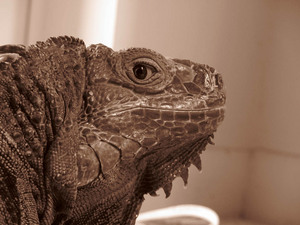An exotic pet can seem inviting and exciting. Especially with younger people, the idea of owning an unusual animal for a pet seems like a great way to add a new dimension to life. Today, one of the exotic pets of choice is an iguana. The problem with exotic pets is that their living requirements are foreign to most people. One of the first things encountered by new owners is the need to construct or buy a suitable habitat for the iguana. These can be built at home with a little research, thought, and ingenuity.
Plan on a large enclosure for the iguana habitat.
Iguanas grow quickly. They also get quite large. An adult iguana can reach a length of five feet. This means that if you try to put the lizard in something small, you must plan on upgrading the habitat every few months for a year or more. It is better to just start big. Plan on your iguana cage being one of the largest pieces of furniture in your home. The completed iguana habitat will need to be about eight feet long, six feet tall, and four feet wide. Anything smaller than this should be considered temporary housing for your reptile.
Iguana habitats need multiple temperature zones for best results.
In their natural environment, iguanas live in a temperature range that rarely falls below the upper sixties and rarely rises beyond the upper nineties. Your iguana cage needs to reflect these temperature gradients. For best results, the cage needs to be designed with an area for basking that keeps a constant temperature between 92 and 96 degrees Fahrenheit. An area about ten degrees cooler will give the iguana a place to retreat to when it is getting too warm. Finally, you will need an area that is about ten degrees cooler than that for it to sleep. In the cool area, the temperature should stay at 68 degrees or above. Because this is in the temperature range of most homes, the lowest part of the cage is taken care of by just letting it stay at room temperature.
Use light bulbs or small heaters to produce the highest temperature area.
By placing a 100 watt light bulb inside a hood on the screened top of the cage, enough heat will probably get inside the upper level of the cage to produce the warmest temperature. This needs to be operational for about 12 hours per day. You also need a light that produces significant UVB rays to help the iguana digest its food. This light should be in the hood with the heat source and operate during that same 12 hour period.
By using shades, you can produce the middle range of temperatures.
As long as you have something that blocks the heat from reaching past the top 18 inches of the cage, you should be able to get a temperature range in the eighties in the middle of the cage vertically. If you find it falling to lower temperatures, you may need to install a small heater that will regulate the heat level.
Since iguanas prefer high humidity, you will need to arrange for some type of humidifier to operate inside the cage.
If the cage is not over ventilated, you should not need to run this device more than a few hours per day to keep it nice and moist inside the cage. By placing a thermometer in the cage that measure relative humidity, you can monitor the temperature and keep track of whether you are keeping it humid enough for the lizard. If it gets too dry, you can spray mist directly onto the animal to help the situation.
Build the cage out of wood, glass or Plexiglas, and screen wire.
If you plan to anchor the cage to a wall, you can just build a simple wooden frame, cover it with whatever material that you plan to use, and screw it to the wall. If the cage will be free-standing, make sure that you install enough bracing to make the cage stable and solid. Cover it with Plexiglas or glass on the front to give you a good view of your pet and to add extra strength to the cage. The rest of the cage can be covered with a wire mesh that is a large enough gauge to hold the force of the iguana.
